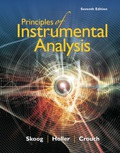
(a)
Interpretation:
The requirements for vibrational mode in a molecule to show IR absorption, Raman active, reason for difference between IR spectrometry and Raman active, circumstances under which vibration mode be both Raman and IR active, circumstances under which the vibration mode be Raman active but not IR active and vice versa is to be stated.
Concept introduction:
The IR spectrometry or infrared spectrometry is the study of infrared light which is interacting with the molecule. The ways to analyze the infrared light are by the measuring the absorption, by measuring the emission and by measuring the reflection.
The Raman spectrometry is the study of molecular vibration which is due to the change in the polarizability of the molecule. The molecule is said to be Raman active, if vibration of the molecule causes the permanent change of dipole moment.
(b)
Interpretation:
The vibration modes of chloroacetonitrile
Concept introduction:
The mode of vibration is of either IR active or Raman active. The asymmetric, symmetric, wagging, twisting, scissoring and rocking are the types of normal modes of vibration of the molecule.
The number of vibration mode for the linear molecule is given by
(c)
Interpretation:
The conclusion of the
Concept introduction:
The IR spectrometry or infrared spectrometry is the study of infrared light which is interacting with the molecule. The ways to analyze the infrared light are by the measuring the absorption, by measuring the emission and by measuring the reflection.
The Raman spectrometry is the study of molecular vibration which is due to the change in the polarizability of the molecule. The molecule is said to be Raman active, if vibration of the molecule causes the permanent change of dipole moment.
(d)
Interpretation:
The comparison of the contrast of IR and Raman spectrometry with respect to optics, cell materials, sample handling, solvent compatibility and applicability of the various sample types.
Concept introduction:
The IR spectrometry or infrared spectrometry is the study of infrared light which is interacting with the molecule. The ways to analyze the infrared light are by the measuring the absorption, by measuring the emission and by measuring the reflection.
The Raman spectrometry is the study of molecular vibration which is due to the change in the polarizability of the molecule. The molecule is said to be Raman active, if vibration of the molecule causes the permanent change of dipole moment.
(e)
Interpretation:
The comparison and contrast of the sources and transducer used in Raman spectrometry and FTIR instruments.
Concept introduction:
The FTIR spectrometry is the type of IR spectrometry which uses the heated inert solid. The IR spectrometry or infrared spectrometry is the study of infrared light which is interacting with the molecule. The ways to analyze the infrared light are by the measuring the absorption, by measuring the emission and by measuring the reflection.
The Raman spectrometry is the study of molecular vibration which is due to the change in the polarizability of the molecule. The molecule is said to be Raman active, if vibration of the molecule causes the permanent change of dipole moment.
(f)
Interpretation:
The comparison of the contrast IR and Raman spectrometry with respect to qualitative, usefulness, detection limits, quantitative analysis and instrument complexity.
Concept introduction:
The IR spectrometry or infrared spectrometry is the study of infrared light which is interacting with the molecule. The ways to analyze the infrared light are by the measuring the absorption, by measuring the emission and by measuring the reflection.
The Raman spectrometry is the study of molecular vibration which is due to the change in the polarizability of the molecule. The molecule is said to be Raman active, if vibration of the molecule causes the permanent change of dipole moment.
Trending nowThis is a popular solution!

- Can you please explain this prooblem to me, show me how the conjugation is added, did I add them in the correct places and if so please show me. Thanks!arrow_forwardBasic strength of organic bases.arrow_forwardNucleophilic Aromatic Substitution: What is the product of the reaction? What is the name of the intermediate complex? *See imagearrow_forward
- The answer here says that F and K have a singlet and a doublet. The singlet and doublet are referring to the H's 1 carbon away from the carbon attached to the OH. Why don't the H's two carbons away, the ones on the cyclohexane ring, cause more peaks on the signal?arrow_forwardDraw the Birch Reduction for this aromatic compound and include electron withdrawing groups and electron donating groups. *See attachedarrow_forwardShow the correct sequence to connect the reagent to product. * see imagearrow_forward
- Blocking Group are use to put 2 large sterically repulsive group ortho. Show the correct sequence toconnect the reagent to product with the highest yield possible. * see imagearrow_forwardElimination-Addition: What molecule was determined to be an intermediate based on a “trapping experiment”? *please solve and see imagearrow_forwardShow the correct sequence to connect the reagent to product. * see imagearrow_forward
 Principles of Instrumental AnalysisChemistryISBN:9781305577213Author:Douglas A. Skoog, F. James Holler, Stanley R. CrouchPublisher:Cengage Learning
Principles of Instrumental AnalysisChemistryISBN:9781305577213Author:Douglas A. Skoog, F. James Holler, Stanley R. CrouchPublisher:Cengage Learning Physical ChemistryChemistryISBN:9781133958437Author:Ball, David W. (david Warren), BAER, TomasPublisher:Wadsworth Cengage Learning,
Physical ChemistryChemistryISBN:9781133958437Author:Ball, David W. (david Warren), BAER, TomasPublisher:Wadsworth Cengage Learning, Principles of Modern ChemistryChemistryISBN:9781305079113Author:David W. Oxtoby, H. Pat Gillis, Laurie J. ButlerPublisher:Cengage Learning
Principles of Modern ChemistryChemistryISBN:9781305079113Author:David W. Oxtoby, H. Pat Gillis, Laurie J. ButlerPublisher:Cengage Learning



